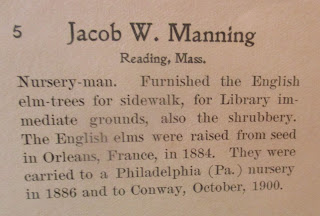It is a little late, but spring is finally bursting out all over, including at the Conway Public Library, where you will find the bees busy around the many flowering trees and shrubs. However, you won't find any of the original English Elms planted in 1900.
However, you can find out about the long history of landscaping and gardening at the library starting in the red room with our original Nursery-Man, Jacob W. Manning, of Reading, Mass.
There you will find his portrait and a caption that reads, ...
I find it particularly interesting that they documented the provenance of the trees, "The English elms were raised from seed in Orleans, France, in 1884. They were carried to a Philadelphia (Pa.) nursery in 1886 and to Conway, October 1900."
Jacob Warren Manning and his five sons were prominent in New England horticultural history.
According to one of their period trade catalogs, the price for an English elm would have been 75 cents.
Our nursery-man's house has even been placed on the National Register of Historic Places.
The Jacob Manning House is a historic house at 140 High Street in Reading, Massachusetts. Built in 1877 for garden nursery owner Jacob Manning, this 2.5 story wood frame house is an excellent local example of Stick style architecture. It has a steeply pitched roof, multiple gables, tall thin windows, and decorative half-timber woodwork. The owner, Jacob Manning, owned one of the largest nurseries in the area, and was responsible for the landscaping of the Massachusetts pavilion at the 1893 Chicago World Fair.
Landscape architecture is an ephemeral and mercurial practice. Over the years there have been many changes in the landscape around the library.
The original rendering for the building shows only low shrubs.
A photo taken in 2000 during the 100th anniversary of the library (see the banner over the north entrance) shows pair of trees flanking a walkway (all of which has changed now).
Like any form of artistic expression, landscape architecture is influenced by changes in fashion and style. The specification for an English elm harkens across the pond to the world wide 18th century phenomenon of the seemingly "natural" English country gardens of Capability Brown and Humphrey Repton and his famous "red books" as opposed to more formal, symetrical and fancy French gardens of the 17th century.
At one time there was a a proposal for a skating rink or tennis court in the library park.
Detail (click on image to enlarge)
The granite plaque near the entrance of the library indicates the landscape design for the expansion was led by John Wacker and Associates.
Most recently there has been the addition of food gardening in raised beds. It is interesting to think how the landscaping will change and where it will go in the future. Personally I am looking forward to the addition of an indoor heated pool and hot tub complete with a waterfall, slide and open atrium so patrons can float in the pool while gazing at the stars and of course, an open pit fireplace and grill for s'mores.
For those visiting the Conway Public Library, there is always the eternal spring garden at the entrance to the Children's Room. (Gift of the Marshall and Lucy Family)
The scene transforms the columns into tree trunks. A careful observer may notice a tree frog climbing on the bark.
The artist makes it look like the donor plaque is hanging from a branch and has a bird's nest on top of it. An emergency light has been turned into a bird house.
Be sure to look beyond the canopy and not miss the whimsical hot air balloon.
















No comments:
Post a Comment